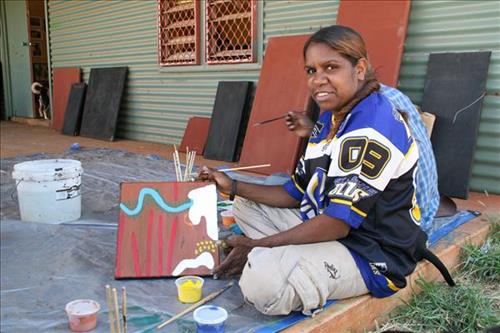111581960308
Marlukururrpa (sturt desert peas)
Depicted in this work are marlukururrpa (sturt desert peas), a striking flowering plant that seasonally produces edible wama (nectar). Marlukururrpa are found in the arid regions of central and north western Australia, and flower following the rains. Their martu name roughly translates to ‘kangaroo’s eyes’, relating to their distinctive red flowers, each containing a large bulbous ‘eye’.
During the pujiman (traditional, desert dwelling) period, Martu would traverse very large distances annually in small family groups, moving seasonally from water source to water source, and hunting and gathering bush tucker as they went. Whilst desert life has moved away from mobile hunter-gatherer subsistence throughout the course of the twentieth century, bush tucker continues to be a significant component of the modern Martu diet. Hunting and gathering bush tucker remains equally valuable as an important cultural practice that is passed on intergenerationally. Though hunting and gathering implements have been modernised, methods of harvesting, tracking and the use of fire burning to drive animals from their retreats are still commonly practiced today.
Marlukururrpa are found in the arid regions of central and north western Australia, and flower following the rains. Their martu name roughly translates to ‘kangaroo’s eyes’, relating to their distinctive red flowers, each containing a large bulbous ‘eye’.
During the pujiman (traditional, desert dwelling) period, Martu would traverse very large distances annually in small family groups, moving seasonally from water source to water source, and hunting and gathering bush tucker as they went. Whilst desert life has moved away from mobile hunter-gatherer subsistence throughout the course of the twentieth century, bush tucker continues to be a significant component of the modern Martu diet. Hunting and gathering bush tucker remains equally valuable as an important cultural practice that is passed on intergenerationally. Though hunting and gathering implements have been modernised, methods of harvesting, tracking and the use of fire burning to drive animals from their retreats are still commonly practiced today.




